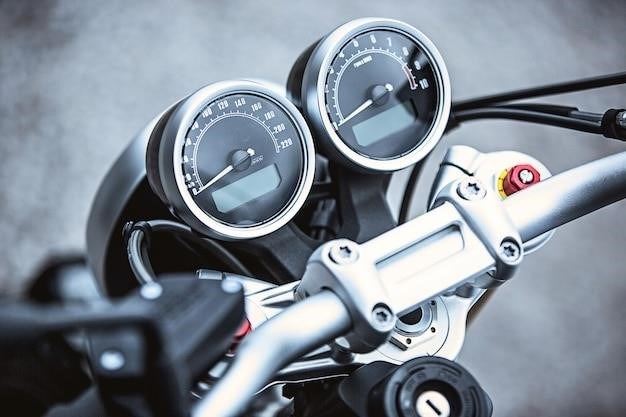Manual vs․ Automatic Transmission Motorcycles⁚ Which is Right for You?
Choosing between a manual and automatic transmission motorcycle can be a tough decision, as each option offers unique advantages and disadvantages․ Ultimately, the right choice depends on your individual riding style, preferences, and experience level․ This article will delve into the pros and cons of each transmission type, helping you make an informed decision about the best motorcycle for your needs․
Introduction
The motorcycle world has seen a significant shift in recent years, with automatic transmissions gaining popularity alongside traditional manual transmissions; While manual motorcycles have long dominated the market, the rise of automatic options has introduced a new dimension to the riding experience․ This shift is largely attributed to advancements in technology, with manufacturers like Honda and Yamaha leading the way in developing sophisticated automatic transmission systems․ This evolution has sparked a debate among riders⁚ which transmission type is better suited for the modern motorcycle enthusiast? This article will explore the key differences between manual and automatic motorcycle transmissions, examining their respective advantages and disadvantages, and ultimately helping you decide which type is right for you․
Manual Transmission Motorcycles
Manual transmission motorcycles have long been the standard, offering a classic and engaging riding experience․ They feature a clutch lever and a gear shifter, requiring the rider to manually engage and disengage the clutch and select the appropriate gear․ This direct control over the motorcycle’s power delivery is a hallmark of the manual transmission experience․ A manual motorcycle typically has a six-speed transmission, allowing riders to fine-tune their speed and power output based on the riding conditions․ They are often favored by experienced riders who appreciate the tactile feedback and control that comes with manual shifting․ However, mastering the art of manual shifting can be challenging for beginners, requiring practice and coordination to smoothly operate the clutch and shifter․
Advantages of Manual Transmission Motorcycles
Manual transmission motorcycles offer a number of advantages that appeal to many riders․ One key benefit is the level of control they provide․ By manually shifting gears, riders can precisely adjust the motorcycle’s power output to suit different riding situations, such as accelerating quickly, maintaining speed on hills, or navigating tight corners․ This control also translates to a more engaging and rewarding riding experience, as riders actively participate in the motorcycle’s performance․ Another advantage is the potential for better fuel efficiency․ Manual transmissions can be more efficient than automatic transmissions, as they allow riders to optimize gear selection for optimal fuel consumption․ Additionally, manual motorcycles tend to be lighter than their automatic counterparts, which can contribute to a more agile and responsive handling experience․ The wide availability of manual motorcycles, with a vast selection of brands and models, also makes finding the perfect bike for your needs a relatively easy task․
Disadvantages of Manual Transmission Motorcycles
While manual transmission motorcycles offer a range of advantages, they also come with some drawbacks that some riders may find challenging․ One of the most significant downsides is the learning curve associated with operating a manual transmission․ Mastering the clutch, shifting gears, and coordinating these actions with throttle control requires practice and can be frustrating for beginners․ Another disadvantage is the potential for increased fatigue, particularly during long rides or in heavy traffic․ Constantly shifting gears and engaging the clutch can strain the rider’s hand and leg muscles․ Manual transmissions also require more rider input and concentration, which can be demanding, especially in challenging riding conditions․ Additionally, some riders may find that the constant shifting and clutch engagement detract from the enjoyment of riding, as it can disrupt the flow and create a sense of being disconnected from the motorcycle’s performance․ Overall, while manual transmissions offer a rewarding experience for many riders, they can present challenges for some, particularly those seeking a more relaxed and less demanding riding experience․
Automatic Transmission Motorcycles
Automatic transmission motorcycles have gained significant popularity in recent years, offering a convenient and user-friendly riding experience․ These motorcycles utilize a system that automatically shifts gears, eliminating the need for the rider to operate a clutch or manually change gears․ This feature makes automatic motorcycles particularly attractive to beginners, as it simplifies the learning process and allows riders to focus on mastering other aspects of riding․ Automatic transmissions also offer a more relaxed and less demanding riding experience for seasoned riders, particularly in urban environments or during long rides․ The absence of manual gear changes reduces fatigue and allows riders to enjoy the ride without the constant engagement required by manual transmissions․ Moreover, automatic motorcycles often feature advanced electronic control systems that optimize gear selection for various riding conditions, further enhancing the riding experience․ While automatic transmission motorcycles may not offer the same level of control and engagement as manual motorcycles, they provide a smooth, effortless, and convenient riding experience that appeals to a wide range of riders․
Advantages of Automatic Transmission Motorcycles
Automatic transmission motorcycles offer a range of benefits that make them an appealing choice for many riders․ One significant advantage is their ease of use, particularly for beginners․ The absence of a clutch and manual gear shifting eliminates the need for complex coordination and allows riders to focus on mastering other aspects of riding, such as balance and steering․ This simplification of the riding experience makes it more accessible to new riders and can reduce the learning curve․ Another advantage of automatic transmissions is their convenience, especially in urban environments or during long rides․ The automatic gear shifting reduces rider fatigue and allows for a more relaxed and enjoyable experience, especially when navigating heavy traffic or riding for extended periods․ Automatic transmissions also offer improved comfort and smoothness, as they eliminate the jerkiness and abruptness associated with manual gear changes․ This smoother riding experience can be particularly beneficial for riders who prefer a more relaxed and comfortable ride․ Overall, automatic transmission motorcycles provide a user-friendly, convenient, and comfortable riding experience, making them an excellent choice for a wide range of riders․
Disadvantages of Automatic Transmission Motorcycles
While automatic transmissions offer numerous advantages, they also come with some drawbacks that may make them less appealing to certain riders․ One significant disadvantage is the potential for reduced performance and control․ Automatic transmissions often have slower acceleration and less responsiveness compared to their manual counterparts, as the automatic gear changes can introduce a slight lag in power delivery․ This can be noticeable during spirited riding or when quick acceleration is needed․ Another drawback is the limited customization and control over gear selection․ Automatic transmissions typically lack the ability to manually select gears, which can be a disadvantage for experienced riders who prefer to have precise control over gear ratios․ This can also limit the rider’s ability to optimize gear selection for specific riding conditions, such as when tackling challenging terrain or maximizing fuel efficiency․ Additionally, automatic transmissions can sometimes be more expensive than their manual counterparts, as the technology involved can be more complex․ While automatic transmissions offer convenience and ease of use, they may not be the ideal choice for riders who prioritize performance, control, or cost-effectiveness․
Choosing the Right Transmission
Ultimately, the decision of whether to choose a manual or automatic transmission motorcycle comes down to personal preference and riding style․ For new riders, the ease of use and convenience offered by automatic transmissions can be a major advantage․ The absence of a clutch and gear shifter simplifies the learning process and allows riders to focus on mastering the fundamentals of motorcycle control․ On the other hand, experienced riders who value performance, control, and the thrill of manual shifting may find manual transmissions more rewarding․ The ability to precisely select gears and experience the direct connection between the engine and the rear wheel can enhance the riding experience and provide a sense of accomplishment․ If you’re unsure which transmission type is right for you, consider taking test rides on both manual and automatic motorcycles to get a feel for each․ This will help you determine which transmission best suits your individual needs and preferences․
Types of Automatic Transmissions
While the term “automatic transmission” might seem straightforward, there are actually several different types of automatic transmissions used in motorcycles․ The most common type is the Continuously Variable Transmission (CVT), which uses a belt and pulley system to provide a seamless and smooth gear change․ CVTs are known for their fuel efficiency and relaxed riding experience, as they eliminate the need for traditional gear shifting․ Another type of automatic transmission is the Dual Clutch Transmission (DCT), which utilizes two separate clutches to seamlessly shift gears without any interruption in power delivery․ DCT systems offer quick and precise gear changes, often exceeding the speed of manual transmissions․ They are becoming increasingly popular in high-performance motorcycles, offering the best of both worlds⁚ the convenience of an automatic transmission and the performance of a manual․ Finally, some motorcycles employ a semi-automatic transmission, which requires the rider to select gears using a lever but automates the clutch operation․ This type of transmission provides a balance between manual control and convenience, offering a more engaging riding experience than a fully automatic transmission while eliminating the need for manual clutch operation․

The Future of Motorcycle Transmissions
The future of motorcycle transmissions is likely to be driven by a continued push towards greater convenience, efficiency, and performance․ Automatic transmissions, particularly DCT systems, are expected to become increasingly prevalent as manufacturers strive to offer a more accessible and enjoyable riding experience for a broader range of riders․ The development of advanced electronic control systems will further enhance the performance and efficiency of automatic transmissions, allowing for smoother and faster gear changes, optimized engine performance, and improved fuel economy․ However, manual transmissions are not likely to disappear entirely․ Many riders appreciate the engagement and control offered by manual gear shifting, and manufacturers will continue to offer manual transmission options for those who prioritize a more traditional and engaging riding experience; Ultimately, the future of motorcycle transmissions is likely to involve a continued evolution of both manual and automatic systems, with advancements in technology driving improvements in performance, efficiency, and rider experience․
The choice between a manual and automatic transmission motorcycle ultimately boils down to personal preference and riding style․ Manual transmissions offer a more engaging and rewarding experience, while automatic transmissions provide greater convenience and ease of use, especially for novice riders․ The future of motorcycle transmissions appears to be a blend of both options, with advancements in technology leading to increasingly sophisticated and efficient automatic systems, while manual transmissions continue to appeal to those seeking a more traditional and engaging riding experience․ Ultimately, the best choice is the one that best suits your individual needs and preferences․ Whether you opt for the precision and control of a manual transmission or the convenience and ease of an automatic, there is a motorcycle out there that will provide you with an enjoyable and fulfilling riding experience․






